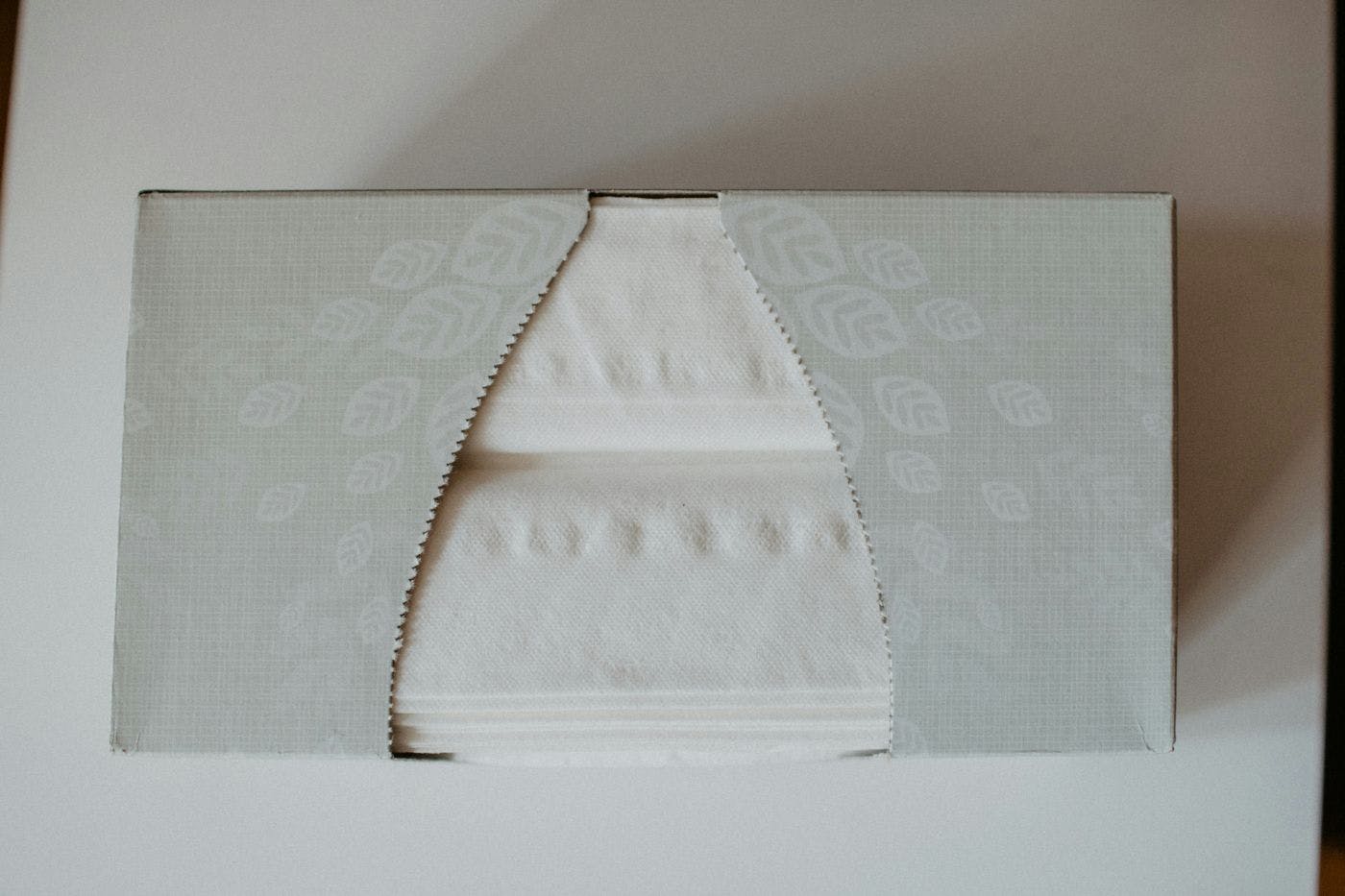

How does this happen? How does a brand not just sell a product but become the word for the thing itself? That’s what we’re diving into today. We’re talking Kleenexes, Legos, Velcro, and more—why they matter, how they got there.
In 1988, REM released its first greatest hits album, called Eponymous. This had the songs, Radio Free Europe, Fall On Me, Driver 8, The One I Love, and The End of the World as We Know It. Truly a wonderful greatest hits album and one that every REM fan, myself included, cherishes. Eponymous means giving their name to or named after a particular person. We encounter these eponymous situations all the time, and sometimes, we don't even know it.
You know those moments when you realize you’ve been lying to everyone your whole life? I just had one. I was at a party, and someone asked for a tissue. Without thinking, I said, “Here, take a Kleenex.” And suddenly it hit me: I don’t even know if it was actually a Kleenex. Maybe it was a generic tissue from the dollar store. Maybe I just ruined a perfectly good relationship with a tissue brand I can’t even afford to defend in court.
That’s the magic—and terror—of eponymous brands: they become so woven into our lives that the product and the brand are interchangeable. Kleenex isn’t just a brand of tissues; it is the tissue. Rollerblade isn’t just a roller skate; it is rollerblading. Lego isn’t a plastic brick; it’s a childhood obsession you’ll pay $400 for when your inner adult refuses to let it go. And somewhere along the line, companies like Jell-O, Band-Aid, and Q-tip managed to sneak their way into our language, our homes, and, honestly, our lazy shorthand for life.
How does this happen? How does a brand not just sell a product but become the word for the thing itself? That’s what we’re diving into today. We’re talking Kleenexes, Legos, Velcro, and more—why they matter, how they got there, and what it actually means when the line between brand and product disappears. Spoiler: it’s both amazing and terrifying.
What Makes a Brand Eponymous?
Let’s pause for a second and define our terms—because “eponymous brand” sounds fancy, but what we really mean is: brands so successful they sneak into your vocabulary without asking.
It’s one thing to sell a product. It’s another to own the product in people’s heads. When a brand becomes eponymous, asking for the product is basically the same as asking for the brand. You don’t just “search the internet” anymore; you “Google it.” You don’t just put a bandage on your finger; you slap on a Band-Aid. And, for better or worse, you don’t just grab a tissue—you grab a Kleenex.
So how does this happen? There’s no single magic formula, but a few recurring ingredients:
1. Total Market Domination (or at least mindshare domination)<br />You can’t become the thing people say when they need it if you barely exist. The brand has to saturate the market—whether through advertising, retail presence, or sheer ubiquity—until it’s literally everywhere. Think: Jell-O in every grocery store aisle in America in the 1950s. Or Lego, slowly colonizing every toy chest in the known universe.
2. A Name That Sticks<br />If your brand name is too complicated, too generic, or just awkward to say out loud at dinner parties, it’s not going to become eponymous. It needs to roll off the tongue like butter on toast. “Kleenex” is smooth; “Generic Tissue Brand #437” is not. (Trust me, I tried.)
3. Pop Culture Integration<br />Movies, TV, memes, viral videos—whatever keeps your brand name in people’s heads long after they leave the store. Velcro? That’s a household name because everyone from astronauts to cartoon characters used it, and it somehow made hook-and-loop fasteners cool.
4. Luck & Timing<br />Sometimes, being eponymous is just blind luck. Q-tips could’ve been called “Cotton Swabbies of Doom,” but instead, a short, catchy name hit the right moment in history—and suddenly everyone was swabbing ears like civilized humans.
5. The Right Product + The Right Brand Personality<br />It helps if your product solves a problem people actually care about, and your brand has a personality people want to adopt. Band-Aid is comforting. Lego is joyful. Jell-O is fun (and slightly wobbly). If your product is boring, nobody’s going to say your brand name in casual conversation. Sorry, Generic Stapler Company.
The end result? The brand and the product merge in our minds, and language evolves around it. We forget the brand came first; we just know the product—and that’s exactly what the companies wanted, while also silently sweating over trademark lawyers in the background.

Iconic Examples of Eponymous Brands
If Section 1 was the “how,” Section 2 is the “look at this insane stuff that actually happened” section. These are the brands that didn’t just sell products—they became the product in our minds.
1. Kleenex → Tissues<br />Kleenex didn’t just corner the tissue market; it cornered the way we talk about sneezing, crying, and awkward dinner moments. Introduced in 1924 as a cold cream remover (yes, really), it pivoted to facial tissues in the 1930s. Suddenly, asking for a Kleenex was easier than “May I have a disposable paper handkerchief, please?”—and just like that, your grandma’s purse was forever stocked with branded salvation.
2. Band-Aid → Adhesive Bandages<br />This one’s almost literal magic. Invented in 1920 by Johnson & Johnson, Band-Aids were a practical solution to minor injuries—and a masterclass in branding. Instead of “stick-on bandage,” which sounds like something you might find in a medieval first-aid kit, Band-Aid was catchy, comforting, and consumer-friendly. Now, when your kid slams a finger in a door, you reach for a Band-Aid, not an adhesive dressing. Your kid doesn’t care about trademarks—they care about style.
3. Lego → Plastic Building Blocks<br />The Danish toy company started in 1932, making wooden toys, but it wasn’t until the 1950s, with the patented brick design, that Lego became a verb, a noun, and an obsession. Kids—and adults—are still building Lego castles, spaceships, and terrifying Death Star replicas today. It’s no longer just a toy; it’s a lifestyle, a meme generator, and proof that plastic can outlive us all.
4. Rollerblade → Inline Skates<br />Before the 1980s, people didn’t “rollerblade.” They…roller-skated. Boring. The Minnesota-based company Rollerblade didn’t just sell a product—they created a sport, a fad, and a verb. Suddenly, teenagers everywhere were cruising suburban sidewalks like they were auditioning for Teenage Mutant Ninja Turtles: The Sequel That Never Happened.
5. Jell-O → Gelatin Desserts<br />Jell-O was already tasty in 1897, but by the 20th century, it became the standard-bearer for wobbly, jiggly dessert. America didn’t just eat gelatin; it Jell-Oed. The brand infiltrated dinner tables, cookbooks, and even home economics classes, making it nearly impossible to separate the dessert from the name. Fun fact: “Jell-O shots” were probably invented shortly after someone realized adult beverages + gelatin = chaotic genius.
6. Q-tip → Cotton Swabs<br />Procter & Gamble struck gold with a simple name and a simple product. Cotton swabs existed before Q-tips, but calling them Q-tips made them approachable. It’s two syllables, easy to say, and rolls off the tongue—plus, it made people feel like little scientists cleaning ears, applying makeup, or fixing tiny art projects. Genius.
7. Velcro → Hook-and-Loop Fasteners<br />Swiss engineer George de Mestral patented Velcro in 1948 after examining burrs on his dog’s fur—true story. The name itself is short, memorable, and fun to say. Now, we don’t say “hook-and-loop fasteners” unless we’re trying to sound like a lawyer. Velcro is in shoes, jackets, space suits, and probably a few weird art projects that no one should know about.
The common thread:
Notice a pattern? These brands:
- Made a product people actually needed<br /><br />
- Had names that were fun, simple, or memorable<br /><br />
- Seeped into culture through usage, media, or sheer ubiquity
They became eponymous because people said the brand name out loud in everyday life. They didn’t just market products; they reshaped language. And, frankly, they got lucky, clever, and relentless all at once.

Why Some Brands Become Eponymous—and Others Don’t
Let’s get real for a second: not every brand is destined for immortality. For every Kleenex or Lego, there’s a “Generic Brand #472” languishing in obscurity, probably still trying to convince someone to “just buy our tissues” with zero cultural resonance. So what separates the legends from the also-rans?
1. Simplicity is King<br />If your brand name requires a breathless explanation or a dictionary, it’s probably not going to become eponymous. Imagine asking your kid to “play with Polyvinyl Chloride Construction Units.” Good luck. Names that are short, punchy, and easy to pronounce are way more likely to worm their way into casual conversation. Kleenex? Two syllables. Lego? Two syllables. Band-Aid? Two syllables. Coincidence? I think not.
2. Market Dominance (aka Ubiquity or ‘If you can’t beat ’em, name it’)<br />You can have a perfect product and a catchy name, but if your brand is barely in stores or constantly out of stock, no one’s going to adopt it into everyday speech. The brand has to reach critical mass—everywhere. People need to be confronted with it so often that using the brand name becomes second nature. Jell-O didn’t just sell gelatin; it invaded kitchens across America.
3. Pop Culture and Timing<br />Being in the right place at the right time matters. Rollerblade didn’t invent roller skating, but they happened to drop their product into the perfect cultural moment: the 1980s, when suburbs were full of bored teenagers, MTV was in full swing, and parents were desperately hoping their kids would exercise outside. Timing + media exposure = eponymous fame.
4. A Product People Actually Care About<br />Some things are inherently boring. Office staplers, generic pens, or socks with mismatched patterns might be functional, but nobody’s going to say “Pass me a Generic Sock” and mean it like it’s a lifestyle choice. To become eponymous, a product has to solve a real problem—or at least entertain us enough that we start using the brand name as shorthand. Band-Aid is comforting. Lego sparks joy. Kleenex solves minor existential crises at dinner tables everywhere.
5. Luck (Yes, Luck)<br />Sometimes, it’s just random chance. A brand name sticks because someone famous said it in a movie, a meme went viral, or your dog happened to drag a product across the living room during a TikTok video. Q-tips could have been Generic Ear Cleaner #1, but instead, a short, snappy name hit the right moment, and culture collectively shrugged and adopted it. Boom—eponymous.
6. Trademark Awareness<br />Finally, there’s the legal side. Some brands actively police their trademark to prevent genericide (looking at you, Google). Others, like Kleenex, more or less shrugged as their name became synonymous with the product. There’s a delicate balance here: you want the cultural love, but you also want to avoid losing your rights. It’s a tightrope walk worthy of a Cirque du Soleil performer.
Bottom line:
Eponymous status isn’t just about selling things. It’s about timing, simplicity, cultural relevance, market domination, and—sometimes—sheer dumb luck. The brands that make it have all the right ingredients, plus a little magic dust sprinkled on top. The brands that don’t? Well…they’re still trying to convince people to “just buy our tissues” while quietly dying in aisle seven.

The Pros and Cons of Being Eponymous
So you’ve made it. Your brand name isn’t just a name—it’s a verb, a noun, a cultural meme, and probably the answer to at least one casual trivia night question. Congratulations! You’ve reached the eponymous peak. But before you start printing “I’m basically a dictionary entry now” on your business cards, let’s talk about what comes next: the upside and the downside of being that brand.
The Pros: Why Eponymous Status is Basically Winning at Life
1. Instant Cultural Recognition<br />Your brand is everywhere—not just on shelves, but in people’s conversations. You don’t have to convince someone to buy your product; they already know it exists. When someone says “Band-Aid” instead of “adhesive bandage,” you’ve basically achieved marketing immortality.
2. Marketing Efficiency<br />When your brand becomes the product, you don’t need long-winded ads explaining what it does. The name is the ad. Lego didn’t need to explain that it was a plastic brick; people already knew and loved it. Google doesn’t need to explain search; it’s the search. This is the lazy marketer’s dream.
3. Cultural Immortality<br />Eponymous brands are woven into language and memory. Your name survives even if your original product doesn’t—or if someone else tries to make it better. People will still say “Velcro” instead of “hook-and-loop fastener,” and you can sleep easy knowing your brand lives on in casual speech, forever.
The Cons: The Secret Dark Side
1. Trademark Erosion (Genericide)<br />There’s a fine line between being loved and being legally neutered. Kleenex and Band-Aid both constantly have to remind people: “Hey, we’re still a brand! Don’t use our name generically in official writing!” If the public keeps treating your brand like a common noun, you risk losing trademark protection. Your immortality comes with lawyers’ invoices.
2. Competitors Might Ride Your Coattails<br />When your name becomes synonymous with the product, everyone else can try to jump on your coattails. Suddenly, “Kleenex” is everyone’s tissues—and while that’s flattering, it also makes it harder to distinguish yourself in the market.
3. Brand Identity Becomes Narrow<br />Being eponymous can trap you in a single-product identity. Velcro doesn’t make chocolate, Lego doesn’t make sandwiches, and Band-Aid doesn’t make…well, anything beyond bandages. Expanding outside your original product can be tricky without confusing your audience. Your fame is a double-edged sword: people love you for what you are, but might resist you as anything else.
4. Everyone Thinks They Own You<br />People love to tell you how they use your product. They might correct your advertising copy in casual conversation, joke about “wrong” ways to Velcro things, or invent ridiculous new uses for your product. It’s flattering until it’s exhausting. Basically, eponymous fame = everyone’s opinion, all the time.
Bottom line:
Being eponymous is like being the popular kid in high school—everyone knows your name, everyone wants to talk about you, and sometimes you get invited to things you don’t even want to attend. It’s a mix of ultimate bragging rights and constant responsibility. But if you pull it off, you’re not just a brand—you’re language. And that’s a rare, rare thing.
Summing Up: What Eponymous Brands Teach Us About Strategy
So, what’s the real takeaway from all this Kleenex-, Lego-, and Band-Aid-fueled chaos? If you want your brand to reach eponymous glory—where people casually use your name as a verb, a noun, and sometimes even a lifestyle choice—here’s what the masters teach us:
1. Solve a Real Problem (or Make People Care)<br />Nobody turns a generic stapler into a cultural icon. Band-Aid works because cuts happen. Kleenex works because sneezes happen. Lego works because childhood—and our inner child—demands chaos and creativity. Make your product truly matter, and the world will start using your name.
2. Make Your Name Memorable<br />Short, punchy, and fun wins. Q-tip didn’t become iconic because it was complicated; it became iconic because it rolls off the tongue like a tiny cotton miracle. Names matter. Words stick. Simple wins.
3. Own the Market—and Culture<br />Being everywhere isn’t enough; you also have to be relevant. Pop culture, media, and perfect timing are what turn a product into a cultural verb. Rollerblade didn’t invent skating—it invented timing, style, and utter coolness.
4. Protect the Brand While Letting It Live<br />Eponymous brands live in language and culture—but trademarks still matter. The trick is letting people use your name without letting it slip into oblivion. It’s a delicate balance, one ThoughtLab sees often when helping clients create category-defining brands: build cultural relevance while keeping legal guardrails in place.
5. Embrace the Chaos<br />Finally, the magic of eponymous status is unpredictability. Your brand will be used in ways you never imagined, adopted in conversations you didn’t script, and turned into memes or metaphors. That’s not failure—that’s proof you’ve created something bigger than a product. You’ve created a brand ecosystem.
Eponymous brands show us what’s possible when strategy meets culture. Your name isn’t just a label—it’s language, lifestyle, and legend. At ThoughtLab, we help brands aim for this kind of cultural immortality, building ecosystems where products, names, and ideas don’t just survive—they thrive.
Because let’s be honest: if your brand isn’t occasionally being used as a verb, are you even playing the game?
